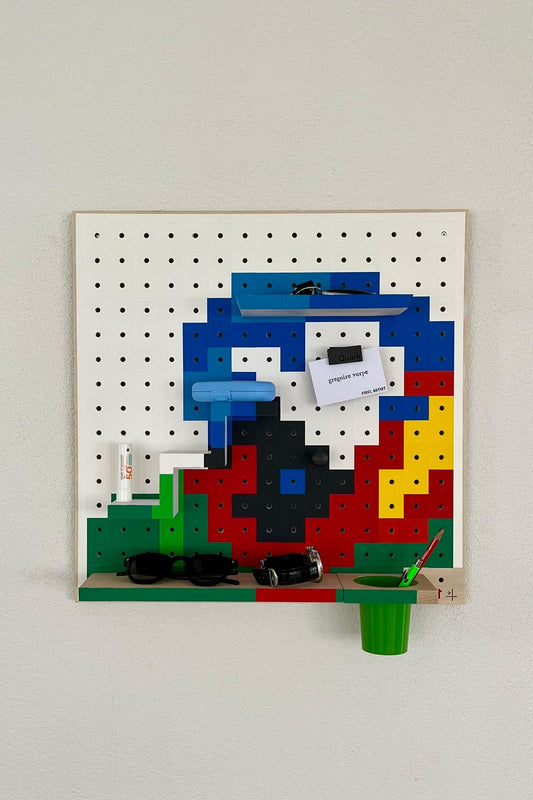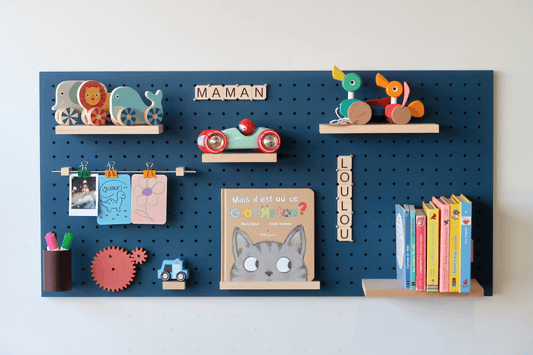Manufacturers produce MDF ( Medium Density Fibreboard ) type wood by bonding wood fibers with a synthetic resin under high pressure and temperature to create a composite material. Manufacturers use this material to make furniture , doors , flooring, and decorative panels . Here is the ultimate guide to MDF : everything you need to know about this innovative material!
What is MDF?
Carpenters and cabinetmakers often use MDF , or “medium density fiberboard” in English, as a material in carpentry and cabinetmaking. Manufacturers compress wood fibers under high pressure and high temperature to create this material. Thanks to this process, we obtain a smooth , dense and homogeneous MDF panel. The advantage is that unlike other types of wood, it does not contain knots or grains , making it easy to work and paint . So if you want to get into carpentry or cabinetmaking and are looking for a material that is easy to work with, MDF could be your solution ;)
A material with many advantages
MDF is available in a wide variety of thicknesses , sizes and finishes , making it versatile and suitable for many applications. It can be used to make furniture , shelves , moldings , doors, floors, and even toys.
MDF is also less expensive than solid wood and more durable than plywood, making it a popular choice for DIY and remodeling projects . It is also environmentally friendly , as manufacturers make it from recycled wood fibers and sawmill residue. Not bad is not it ? Not only can manufacturers divide MDF into different colors, but they also offer several types of MDF.

However, MDF also has some disadvantages. It is therefore less resistant to humidity than solid wood . If the material is exposed to water, it may warp or split. Because it is made from resin and glue , MDF can emit toxic fumes (VOCs) if it is not well ventilated. You must therefore be careful not to expose it to a humid place. And carefully check with professionals that the wood will not release toxic vapors. It is therefore important to take appropriate precautions when handling MDF . Such as the use of a protective mask and adequate ventilation.
What are VOCs or chemical substances?
VOCs are Volatile Organic Compounds , which are chemical substances present in certain products and materials such as paints, varnishes, glues, solvents, cleaning products, floor coverings, furniture, etc. VOCs can evaporate at room temperature and end up in the indoor air of buildings, where they can cause health effects , such as eye and respiratory irritation , headaches, nausea, dizziness and other symptoms. On the other hand, VOC emissions can also contribute to outdoor air pollution and the formation of smog. It is therefore recommended to use low VOC products and to properly ventilate indoor spaces to reduce exposure to VOCs.
How do I know if it is present?
There are several methods to determine if a material contains VOCs:
- Look for information on the product packaging or label. Manufacturers are often required to list the VOC content on the product label or packaging.
- Use VOC detection kits . There are kits available from specialty stores that can help identify the presence of VOCs in materials. These kits often use chemical tests to detect the presence of VOCs.
- Use a VOC detector . VOC detectors are electronic devices designed to measure the concentration of VOCs in the air. You can use a detector to measure the amount of VOCs emitted by a particular material.
And there you have it, now you know how to protect yourself against toxic substances and choose your material wisely.
How to define the durability of a material?
The durability of a material is the measure of its ability to resist wear, degradation and alteration over time. Several factors, including the material's chemical composition, mechanical and physical properties, exposure to extreme environmental conditions, care and maintenance, influence how long it can be used effectively before needing to be replaced or repaired. Sustainability can be assessed based on several criteria, such as:
- Corrosion resistance : the ability of a material to resist corrosion due to adverse environmental conditions, such as moisture, chemicals, salts and other contaminants.
- Wear resistance : the ability of a material to resist wear due to regular use, friction, impacts and other forms of mechanical stress.
- Dimensional stability : the ability of a material to maintain its initial dimensions and shapes under varying environmental conditions, such as changes in temperature and humidity.
- UV resistance : A material's ability to resist fading and degradation caused by the sun's UV rays.
- Breaking strength : the ability of a material to resist breaking under applied loads.
- The length of time a material can be used effectively before needing to be replaced or repaired is measured to assess its useful life .
Sustainability has become a major concern in the design and construction of products and infrastructure. Therefore, by using sustainable materials, we can reduce the environmental impact of our activities . Maintenance costs can be minimized and the lifespan of products and infrastructure extended.
Why use MDF?

Here are some reasons why one might choose to use MDF:
- Cost : MDF is less expensive than many other building materials, such as solid wood or plywood, making it an economical choice for construction and renovation projects.
- Ease of machining: MDF is an easy material to work with, so it is easily machinable. It can be cut, drilled, countersinked, engraved, planed, sanded, painted and stained to meet specific requirements.
- Uniformity : MDF is a homogeneous material, meaning it has a uniform density across its entire surface.
- Resistance to deformation : MDF does not easily deform due to humidity or temperature variations.
- Environmentally Friendly : Manufacturers produce MDF using recycled wood and other recycled materials. Additionally, it can be recycled and reused in other construction projects.
- Versatility : A wide variety of applications, including furniture, doors, moldings, decorative panels, flooring and ceiling panels, are covered by the use of MDF

In conclusion, MDF is a versatile , economical and ecological material. It is suitable for many applications in carpentry and cabinetmaking. However, it also has limitations in terms of water resistance and toxic emissions, which must be taken into account when using it.
How Quark uses MDF?
At Quark we use Valchromat , an MDF made in Portugal. If you don't know what valchromat is, here is a quick definition:
The valchromat

Valchromat is a mass-dyed wood fiber panel material. It offers an attractive alternative to traditional medium density fiberboard (MDF). Unlike MDF, Valchromat is made from wood fibers of different species . They are then bonded together with a water-resistant synthetic resin and dyed throughout. This technique will create a homogeneous and colored surface. The result is a high quality material that can be used for a wide variety of applications. Including furniture construction, flooring and wall panels.
A chameleon material
Valchromat is available in a wide variety of colors and textures. Making it a popular choice for interior design projects. It is also more water resistant than traditional MDF. Which makes it suitable for applications in humid environments. Valchromat is also more resistant to wear and scratches. Which makes it suitable for use in high traffic areas.
In terms of sustainability, Valchromat is an environmentally friendly material. Because it is made from recycled wood and wood from responsibly managed sources . It is also recyclable and can be reused in other construction projects. Additionally, Valchromat is formaldehyde-free, making it a safer choice for interior applications.
Order your Quark sample kit
If you want to know the material a little better and see the colors with your own eyes, you can! You can order your sample kit from Quark . You will then have the opportunity to see the colors, to test the material, and therefore to plan better! If you would like to order a Valchromat sample kit, please feel free to visit our product page.
In summary, Valchromat is a solution-dyed wood fiber panel material that offers many benefits. Especially in terms of water resistance, durability and design versatility. However, it is important to note that Valchromat is more expensive than MDF . It may also require special cutting tools due to its higher density.
And there you have it, valchromat no longer has any secrets for you ;). If you loved all the advantages of MDF and would like to get some, don't hesitate to take a look at our site. Where a wide choice of colors awaits you!






















